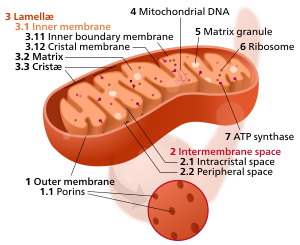Mitochondrial matrix
| Cell biology | |
|---|---|
| mitochondrion | |
 Components of a typical mitochondrion
1 Outer membrane
3 Lamella
4 Mitochondrial DNA |
In the
The composition of the matrix based on its structures and contents produce an environment that allows the anabolic and catabolic pathways to proceed favorably. The electron transport chain and enzymes in the matrix play a large role in the citric acid cycle and oxidative phosphorylation. The citric acid cycle produces NADH and FADH2 through oxidation that will be reduced in oxidative phosphorylation to produce ATP.[2][3]
The cytosolic, intermembrane space, compartment has a higher aqueous:protein content of around 3.8 μL/mg protein relative to that occurring in mitochondrial matrix where such levels typically are near 0.8 μL/mg protein.[4] It is not known how mitochondria maintain osmotic balance across the inner mitochondrial membrane, although the membrane contains aquaporins that are believed to be conduits for regulated water transport. Mitochondrial matrix has a pH of about 7.8, which is higher than the pH of the intermembrane space of the mitochondria, which is around 7.0–7.4.[5] Mitochondrial DNA was discovered by Nash and Margit in 1963. One to many double stranded mainly circular DNA is present in mitochondrial matrix. Mitochondrial DNA is 1% of total DNA of a cell. It is rich in guanine and cytosine content, and in humans is maternally derived. Mitochondria of mammals have 55s ribosomes.
Composition
Metabolites
The matrix is host to a wide variety of
Enzymes
Enzymes from processes that take place in the matrix. The citric acid cycle is facilitated by
Inner membrane components
The inner membrane is a
Inner membrane control over matrix composition
The electron transport chain is responsible for establishing a pH and
Processes
Citric acid cycle
Following glycolysis, the citric acid cycle is activated by the production of acetyl-CoA. The oxidation of pyruvate by pyruvate dehydrogenase in the matrix produces CO2, acetyl-CoA, and NADH. Beta oxidation of fatty acids serves as an alternate catabolic pathway that produces acetyl-CoA, NADH, and FADH2.[1] The production of acetyl-CoA begins the citric acid cycle while the co-enzymes produced are used in the electron transport chain.[11]

All of the
Oxidative phosphorylation
NADH and
Urea cycle
The first two steps of the urea cycle take place within the mitochondrial matrix of liver and kidney cells. In the first step ammonia is converted into carbamoyl phosphate through the investment of two ATP molecules. This step is facilitated by carbamoyl phosphate synthetase I. The second step facilitated by ornithine transcarbamylase converts carbamoyl phosphate and ornithine into citrulline. After these initial steps the urea cycle continues in the inner membrane space until ornithine once again enters the matrix through a transport channel to continue the first to steps within matrix.[12]
Transamination
Regulation
Regulation within the matrix is primarily controlled by ion concentration, metabolite concentration and energy charge. Availability of ions such as
Protein synthesis
The mitochondria contains its own set of DNA used to produce proteins found in the electron transport chain. The mitochondrial DNA only codes for about thirteen proteins that are used in processing mitochondrial transcripts,
See also
References
- ^ ISBN 978-1118129180.
- ^ ISBN 978-0-7167-4684-3.
- S2CID 4149605.
- ^ ISBN 978-0-444-10925-5.
- ^ PMID 15607740.
- ^ PMID 10600673.
- ^ PMID 13221663.
- PMID 24931469.
- ISBN 978-0-8153-3218-3.
- S2CID 4355527.
- ^ S2CID 39165641.
- S2CID 2951786.
- PMID 6143829.
- S2CID 27367543.
- PMID 23212899.
- S2CID 21200502.
